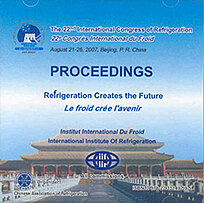
Document IIF
Evaluation des propriétés d'une émulsion d'huile de paraffine en tant que coulis à changement de phase.
Evaluation of properties on paraffin oil-in-water emulsion as phase change slurry.
Auteurs : HUANG L., POLLERBERG C., DÖTSCH C.
Résumé
Paraffin is an easily available organic phase change material. Paraffin oil can be dispersed in the form of a small droplet in water as an oil-in-water emulsion. The binary fluid has a high heat capacity in the phase change temperature range of the used paraffin. The subject of this paper is the evaluation of the potential of paraffin oil-in-water emulsion for the cold energy storage application. The commercial paraffin blend (mixtures of different saturated alkanes) Rubitherm RT10 with a melting temperature of 10°C was used to make the emulsion. The following properties have been investigated of the emulsion: distribution of droplet size and the dependence between supercooling and droplet size; thermal properties as the latent heat of fusion, the phase change temperature range and optimal operation temperature rang in practical application and; rheological properties. A series of samples with weight percentages from 15 to 50% have been prepared. The properties of the emulsion in dependence of the paraffin concentration have been studied. The results show that an emulsion with a paraffin concentration up to 50 weight percent is an attractive candidate for cold storage application due to its high heat capacity.
Documents disponibles
Format PDF
Pages : ICR07-D1-892
Disponible
Prix public
20 €
Prix membre*
Gratuit
* meilleur tarif applicable selon le type d'adhésion (voir le détail des avantages des adhésions individuelles et collectives)
Détails
- Titre original : Evaluation of properties on paraffin oil-in-water emulsion as phase change slurry.
- Identifiant de la fiche : 2008-0670
- Langues : Anglais
- Source : ICR 2007. Refrigeration Creates the Future. Proceedings of the 22nd IIR International Congress of Refrigeration.
- Date d'édition : 21/08/2007
Liens
Voir d'autres communications du même compte rendu (839)
Voir le compte rendu de la conférence
Indexation
-
Low temperature paraffin phase change emulsions.
- Auteurs : HUANG L., DOETSCH C., POLLERBERG C.
- Date : 03/06/2009
- Langues : Anglais
- Source : 8th Conference on Phase-Change Materials and Slurries for Refrigeration and Air Conditioning
- Formats : PDF
Voir la fiche
-
Improving thermal and flow properties of chille...
- Auteurs : LORSCH H. G., MURALI K., CHO Y. I.
- Date : 1997
- Langues : Anglais
- Source : ASHRAE Transactions.
Voir la fiche
-
Formation of tetradecane nano-emulsions by low-...
- Auteurs : SCHALBART P., KAWAJI M., FUMOTO K.
- Date : 03/06/2009
- Langues : Anglais
- Source : 8th Conference on Phase-Change Materials and Slurries for Refrigeration and Air Conditioning
- Formats : PDF
Voir la fiche
-
Development of a new ice making system by using...
- Auteurs : TERAOKA Y., OKADA M., ONODERA Y., et al.
- Date : 21/05/2006
- Langues : Anglais
- Source : ACRA-2006. Proceedings of the 3rd Asian conference on refrigeration and air conditioning.
Voir la fiche
-
A method to determine the thermal conductivity ...
- Auteurs : HOFER S., MURGUET D., SARI O., et al.
- Date : 23/04/2003
- Langues : Anglais
- Source : PCM 2003. Proceedings of the phase change material and slurry scientific conference and business forum.
Voir la fiche
